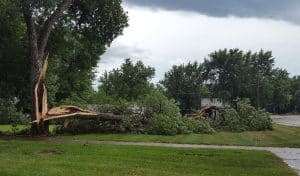Statewide Iowa (RI) – Natural disasters in Iowa that cause millions and even billions of dollars damage are becoming more frequent, which some experts blame on our changing climate.
The 15th annual Iowa Climate Statement was released Monday, endorsed by 177 Iowa science faculty at 24 colleges and universities statewide. Dave Courard-Hauri, a professor of environmental science and sustainability at Drake University, says the cost of disasters like droughts and floods don’t impact just those who file insurance claims.
While farmers are especially vulnerable to natural disasters and their associated costs, the report says the American dream of homeownership may become unattainable for some Iowa families as climate change accelerates the rise in insurance premiums.
Bill Gutowski, professor emeritus of meteorology at Iowa State University, says temperatures are rising globally due to an increase in greenhouse gases which is caused by the burning of fossil fuels.
When adjusted for inflation, the report says billion-dollar disasters in the region encompassing Iowa have more than doubled over the past 40 years.
Peter Thorne, a professor of occupational and environmental health at the University of Iowa, says these Midwest events are part of an emerging global trend of shattered long-term climate records, with growing losses of life and property, resulting in higher insurance costs.
Property owners in Iowa can make moves to try and reduce their own carbon footprints and to reduce their insurance costs.
Emma Stapleton, a research professor of internal medicine at the University of Iowa, says for example, trees can be planted as natural wind buffers, and there are all sorts of “smart” building materials for construction.
The report says some insurance companies have pulled out of Iowa and elsewhere after recent disasters, like the 2020 derecho.
Gutowski says every one of the Earth’s ten hottest years on record has occurred in the last decade, with 2024 breaking all previous records. He says those temperature changes lead to the types of extreme events and damages that we have seen more of in recent years.
For more information, visit: https://ehsrc.public-health.uiowa.edu/
KIWA Staff Photo







